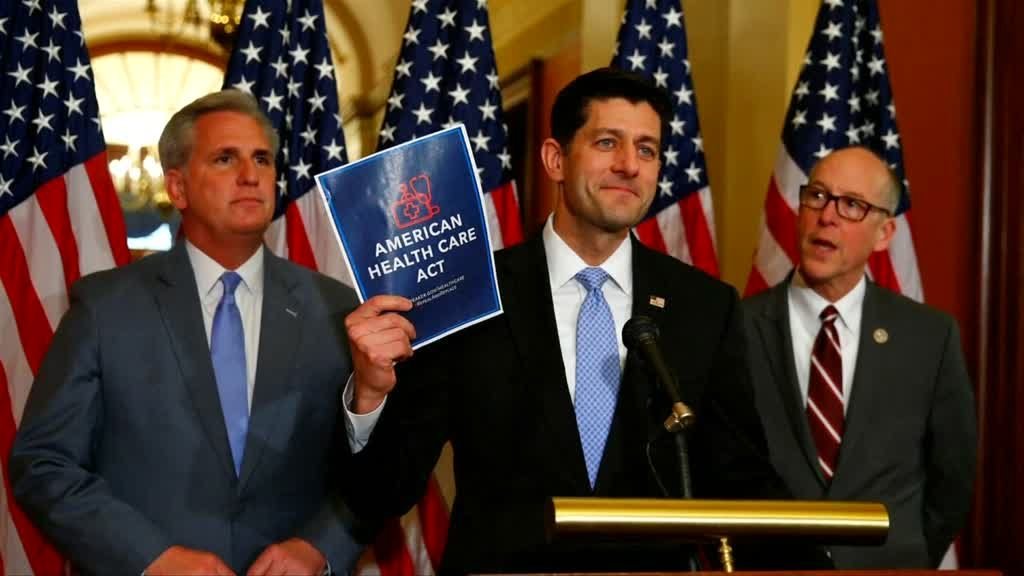

WASHINGTON — Senate Republican leaders released a new version of their health care bill on Thursday and they hope to vote on it as soon as next week. Here’s what you need to know about how it would affect your health care.
Premiums and deductibles
Like Obamacare, the Senate bill provides subsidies to buy insurance on the individual market based on a person’s income. But they’re less generous overall and encourage people to buy plans that cover fewer out-of-pocket costs.
Under the bill, people would be eligible for tax credits with incomes up to 350 percent of the federal poverty line, which is about $86,000 for a family of four. Under Obamacare, the cutoff is 400 percent, which is about $98,000 for the same family.
But the subsidies aren’t for the same insurance. Under Obamacare, they’re pegged to the cost of a “silver plan” that covers 70 percent of average medical costs. Under the Senate bill, the premiums are pegged to the cost of a plan that covers 58 percent of medical costs. People with these plans would face higher out-of-pocket costs: Today, it’s the difference between a plan with an individual deductible of about $3,500 versus a plan with a deductible of about $6,000.
The AARP, which represents seniors and opposed the last Senate bill in part over these provisions, came out strongly against the new version on Thursday. “This bill may have changed but the results are the same: higher costs and less coverage for older Americans,” AARP Executive Vice President Nancy LeaMond said in a statement.
If people go without coverage for more than 60 days, the bill requires them to wait six months before getting health insurance again.
Finally, the bill would eliminate cost-sharing payments that reduce deductibles for low-income Americans with private insurance. A prior analysis of the Senate bill found that ending these payments would raise deductibles from as low as $255 to an average of about $6,000 for some qualifying customers.
States could use money from a temporary stabilization fund in the Senate bill to help offset some of these cuts, but they’d also face pressure to use the cash to make up for reductions elsewhere or try out new policies.
The Congressional Budget Office analysis found a previous version of the bill would cover 22 million fewer people, largely because low-income customers would find the insurance too skimpy to justify the expense.
But there’s a major new provision in the bill that the CBO has yet to analyze that could raise premiums for subsidy-eligible plans across the board, while creating cheaper options for some customers elsewhere.
Pre-existing conditions
The Senate bill would weaken protections for people with pre-existing conditions and push sicker customers toward more expensive plans and healthier customers toward cheaper, less generous plans.
Under Obamacare, insurers are not allowed to deny anyone health coverage for a pre-existing condition or charge them a different price. In addition, every plan has to include the same minimum level of coverage — called “essential health benefits” — so that insurers can’t herd healthier patients into cheap plans that wouldn’t meet basic needs for sicker customers.

The Senate bill would change that. It includes a modified version of a proposal by conservative Senators Ted Cruz, R-Texas, and Mike Lee, R-Utah, that would allow insurers to sell plans that do not meet Obamacare’s regulations.
That means they don’t have to not cover “essential health benefits,” which include everything from hospitalization to maternity care. They could also deny plans to people with pre-existing conditions or charge them more based on their health.
Customers would not be able to use federal subsidies to buy these plans, which would likely have much lower premiums than other coverage, along with high deductibles. That could interest people who don’t qualify for tax credits and don’t have any immediate medical needs, but still want some limited insurance.
If you have expensive medical needs, though, you’d have to turn elsewhere.
The Senate GOP bill creates a temporary $70 billion fund to help insurers pay for more expensive patients, but only if they sell comprehensive plan that contain “essential health benefits” and meet other Obamacare regulations. Since these plans would be far more attractive to sicker patients and the skimpier plans far more attractive to healthy people, the premiums would likely become more expensive.
AHIP, the main lobby for insurance companies, has come out strongly against proposals along these lines, warning it would destabilize insurance markets by segregating sicker customers into ultra-expensive plans.
For plans that are eligible for subsidies on Obamacare’s exchanges, there could be changes to “essential health benefits” as well. The Senate bill would allow states to waive the benefit rules in favor of their own version. In states that reduced or eliminated these benefits, healthy people could gravitate toward cheaper and less generous plans, further driving up costs for more comprehensive coverage.
Treatments left out of essential health benefits could also become subject to annual or lifetime limits by insurance companies, a practice that was banned under Obamacare.
This change could potentially affect benefits for employer plans as well, according to some health experts who have examined the bill. Current regulations require employers to provide coverage that’s consistent with essential benefit rules in a state of their choosing. That means if one state deregulates their plans, it could give employers around the country the ability to adopt their rules and provide plans with fewer benefits and with annual and lifetime limits.
Medicaid
The Senate bill would reduce Medicaid spending dramatically compared to current law.
It would gradually eliminate Obamacare’s Medicaid expansion, which covers people making up to 138 percent of the federal poverty line (about $16,500 for individuals) in participating states. About 11 million people have gained coverage under this provision.
Going further than rolling back Obamacare’s Medicaid provisions, it would also reorganize Medicaid and cap federal spending on a per-person basis, which is a major change from the current system that matches states based on their own contribution to the program.
The bill would also grow future Medicaid spending at what’s expected to be a slower rate than current law, leading to deeper reductions in spending over time.
The CBO found these changes, which were in the previous version of the bill, would reduce Medicaid spending by $772 billion over the next decade in comparison to current law and cover 15 million fewer people. States would have to either raise taxes or cut spending elsewhere to make up the difference or reduce benefits for Medicaid recipients like nursing home residents and people with disabilities.
There are some tweaks in the new version. It includes a mechanism that would let states increase Medicaid spending if there’s a health emergency that drives up per-person costs. The bill also changes a formula to help hospitals pay for low-income patients in a way that benefits states with more uninsured people, which would likely help states that chose not to expand Medicaid.
The CBO and outside experts will have to weigh in on the new provisions, but they’re unlikely to offset the old version’s spending reductions by large amounts.
Taxes
The Senate bill will eliminate Obamacare’s taxes on medical companies and remove its penalties on individuals who don’t buy insurance and employers who don’t provide it.
Notably, though, it will keep taxes on high-income households that were created to finance Obamacare: A 3.8 percent tax on investment income for families making over $250,000 a year and a 0.9 percent Medicare payroll tax. The bill also keeps a tax on health insurance CEOs personal earnings.
This frees up the bill to spend more elsewhere and addresses complaints by moderate Republicans over criticism that the previous version cut spending for low-income households and used the savings to lavish tax cuts on the rich.
The new bill does add a tax break favored by conservatives that primarily helps higher-income families. It allows people to pay for premiums on individual insurance plans using their tax-exempt contributions to a Health Savings Account. Since lower income households usually don’t have extra cash to contribute to an HSA, the change is unlikely to benefit them much. The tax benefits are also proportionally bigger for people in higher income tax brackets.
Abortion

The bill would cut off Planned Parenthood from receiving Medicaid payments. The organization is already barred from accepting federal contributions for abortion, but is reimbursed by the government for other treatments.
Insurers would also not be allowed to offer individual plans eligible for subsidies that cover abortion. Under Obamacare, insurers can include abortion coverage, but the provision is paid for separately using premiums and not federal subsidies.
[“Source-nbcnews”]




